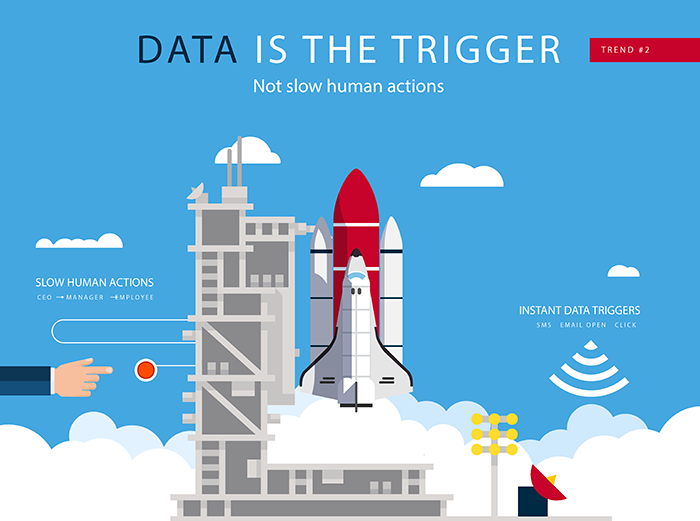4 Hot Business Intelligence Trends: Data is the Trigger (Part 2 of 4)
Siri, Alexa, Cortana and Google Now are just the beginning. When it comes to getting things done, machines are increasingly edging humans out of the equation. Big data and analytics are at the core of what some people are calling the “bot revolution.”
Bots have actually been around for a long time, but their early iterations were robotic and not very intuitive. Recent advances in machine learning, language processing and mobility, however, are creating an explosion of new opportunities to put bot to use in much more sophisticated ways. And when you connect them to each other, things really get interesting.
Tell Amazon’s Echo that you want an Uber at your doorstep and the system fires off a request to another app that locates a nearby driver and sends an automated message instructing him where to go. There is no human-to-human communication, and therefore no mistakes, no misunderstandings and no time wasted on musical hold. Echo will even keep you informed of your driver’s progress toward your front door.
But bots are just one manifestation of a more sweeping revolution in automated messaging. These examples and more prosaic, but there’s nothing modest about their impact.
For example, machines on the factory floor can now alert automated monitors when certain thresholds are exceeded that point to an imminent failure. That event can trigger a short message service (SMS) to human operator, but it can also alert a process control system to route around the troubled machine or shut it down entirely, then generate a repair order that’s routed to maintenance.
In complex computing environments, systems management software can detect slowdowns or bottlenecks and take different courses of action depending upon the severity of the problem. In many cases the software can resolve the problem without even telling a human that it occurred.
These capabilities are emerging from a convergence of technology developments being driven by the maturation of big data. Among them:
- Machine learning, which is a form of predictive analytics, enables computers to anticipate and understand situations by learning over time. The computer continually tests assumptions, discards failures and builds upon successes. In this way learns that when you ask for “the Beatles,” you want music and not an insect infestation.
- Streaming analytics processes data as it comes in over the wire and makes instantaneous judgments based upon current and historic data. Algorithms can be set to that take actions ranging from automated problem resolution to waking up a supervisor in the middle of the night. Rules can be programmed by humans, but machine learning makes it increasingly viable for computers to diagnose problems and take action without human intervention.
- Underlying all of these developments is big data, which permits the affordable storage and processing of unprecedented amounts of information, and which enables the development of the kinds of scenarios we’ve just described.
One area in which these technologies come together with game-changing potential is in marketing and sales. Marketers have long chased the Holy Grail of “mass customization,” or the delivery of personalized messages, offers and services with mass-market economies of scale. Thanks to cookies and profiles, digital advertisers have been able to target messages for some time. The next frontier is engaging those customers in one-on-one conversations.
Messaging apps are laying the groundwork. The top four mobile messaging apps are now approaching three billion monthly users, more than the top four social networks combined, according to Business Insider Intelligence. Social messaging is the second most-used category of mobile app, behind only Facebook, according to Yahoo’s Flurry Analytics.
Marketers can ride atop the popularity of mobile messaging to provide services that are useful, not just promotional. And that creates a whole different kind of customer engagement. For example:
- A chat bot can respond to a request to provide directions to nearby restaurants along with coupons for sponsoring brands.
- A customer support application can detect when mobile customers are having difficulty with a new app by watching for certain patterns of behavior and dispatch a text messaging offering help based upon the specific problem the customer is having.
- An inventory management system in a retail store can adjust prices on the shelves in real time to account for overages or shortfalls in warehouse stock.
- A customer purchase can automatically trigger an email or text message with offers for other merchandise that the customer is likely to find valuable based upon historic sales patterns. And it can do so before the customer leaves the store.
All of these examples have one thing in common: They’re being used in the field right now. These are just the latest examples of the ways in which customer relationships will be redefined by machine-to-machine communications.
These developments don’t obviate the value of personal interactions. Rather, they take the place of interactions that don’t improve customer experience. How many times have you stood in a long checkout line while the cashier calls around to try to rustle up some relief? In the future, cameras will be able to detect when lines are growing too long and automatically dispatch a call for assistance. Using machine learning, they’ll even be able to detect a backup before it becomes a problem so customers are never inconvenienced.
We call unwanted email “spam,” but what about messages that help us solve a problem or tip us off to an opportunity? That’s when machine-to-machine communications really changes the marketing game.
Learn more by downloading the free book: The Definitive Guide to BI and Analytics on a Data Lake.
| Reference: | 4 Hot Business Intelligence Trends: Data is the Trigger (Part 2 of 4) from our JCG partner Sameer Nori at the Mapr blog. |





